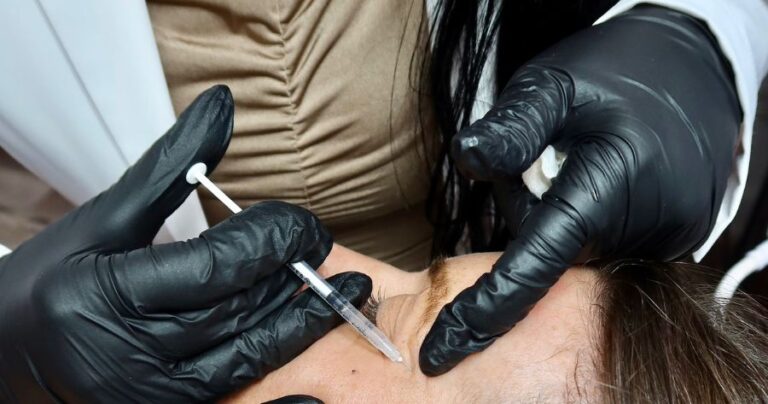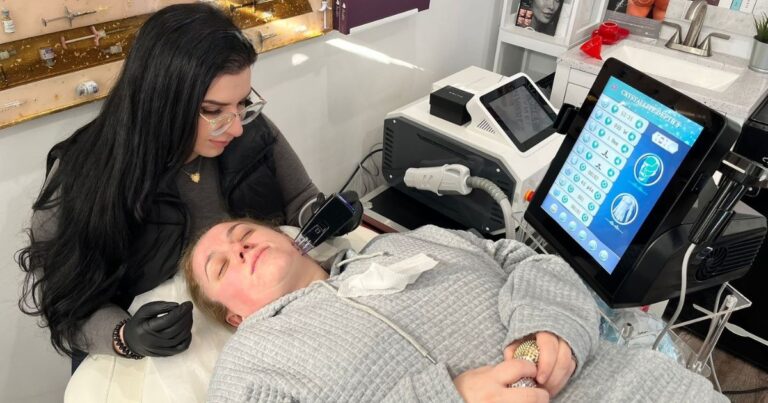Non-surgical fat melting has quickly become one of the most sought-after options for body contouring and for good reason. It offers a way to reduce stubborn fat without needles, anesthesia, or downtime. For anyone who’s close to their ideal weight but struggling with areas that just won’t budge, these treatments can be a game-changer.
But is it right for you?
This article breaks down everything you need to know—from how it works and who it’s best for, to what results you can realistically expect. Whether you’re comparing it to liposuction, curious about the different technologies, or just want to know if it’s worth the money, you’ll find straightforward answers here.
Let’s explore your options and help you make an informed, confident decision about your next step toward feeling more at home in your body.
Table of Contents
What Is Non-Surgical Fat Melting?
Non-surgical fat melting is a treatment that breaks down stubborn fat using heat, cold, or sound—without surgery, needles, or downtime. It targets fat cells under the skin, damages them, and lets your body flush them out naturally over time.
Unlike weight loss, which simply shrinks fat cells, these treatments remove the cells entirely. That means results can last if you keep your weight stable.
How It Works
- Controlled energy is applied to targeted fat pockets.
- Fat cells are disrupted without harming surrounding tissue.
- Over the next few weeks, your body clears out the damaged cells.
- The treated area becomes slimmer and more contoured.
Popular Non-Surgical Fat Reduction Methods
- Cryolipolysis (CoolSculpting): Freezes fat cells using cold temperatures.
- Laser Lipolysis (SculpSure): Heats fat cells with laser energy.
- Radiofrequency (RF) Treatments: Uses RF waves to warm and shrink fat cells.
- Ultrasound Fat Reduction: Applies focused sound waves to break up fat.
Each option works slightly differently, but the goal is the same—reduce fat in areas that don’t respond to diet or exercise.
Next, let’s break down who gets the best results from these treatments.
Who’s a Good Candidate for Non-Surgical Fat Reduction?
Non-surgical fat melting works best for people who are close to their ideal weight but have specific areas they want to slim down. It’s not for weight loss—it’s for shaping. If you’ve got small pockets of fat that don’t budge with diet or exercise, this may be a good fit.
Best Fit for These Goals
- You’re already healthy but want to smooth out areas like your belly, love handles, thighs, or under your chin.
- You want noticeable, natural-looking results without surgery or downtime.
- You’re okay with gradual changes rather than instant transformation.
This isn’t a fix-all. It works on subcutaneous fat (the kind just under the skin), not deeper or internal fat. And while the fat cells are gone for good, you’ll still need to stay active and eat well to maintain results.
Who Should Skip It
- If you’re significantly overweight or looking for fast weight loss, this isn’t the right solution.
- People with loose skin, certain medical conditions, or those who are pregnant should avoid it.
- If you’re hoping for dramatic changes from one session, you’ll likely be disappointed.
Coming up, we’ll look at the biggest benefits of non-surgical fat melting and why so many people are choosing it over traditional procedures.
Benefits of Non-Surgical Fat Melting
Non-surgical fat reduction isn’t just about looking slimmer—it’s about doing it in a way that fits your life. If surgery sounds too intense, this might be the easier path you’re looking for.
No Surgery, No Downtime
These treatments skip the scalpel completely. There’s no anesthesia, no incisions, and no scars. You can walk out of the appointment and head right back to your day. Some people even do it on their lunch break.
Gradual, Natural-Looking Results
Because your body clears out the fat over time, results appear slowly. That makes the change look real—not sudden or “done.” It’s a quiet improvement others notice, but can’t quite put their finger on.
Targets the Spots That Won’t Budge
Everyone has a few trouble spots—under the chin, lower belly, love handles—that don’t respond to clean eating or workouts. This treatment goes straight to those areas and breaks down the fat without affecting the rest of your body.
Permanent Fat Cell Removal
Once fat cells are destroyed and flushed out, they don’t come back. That’s why these results can last, as long as your weight stays consistent. It’s not a free pass to overeat—but it gives you a head start and a push to keep going.
Boosts Confidence Without Disruption
It’s a subtle upgrade, not a dramatic change. But that’s often all people need to feel more confident in clothes, photos, or at the gym. And the best part? You don’t need to take time off or explain anything to anyone.
Now that you know what makes this treatment so appealing, let’s break down what actually happens during a session and how your body reacts afterward.
What to Expect During and After the Procedure
Non-surgical fat melting is simple, but knowing what to expect helps ease nerves and set the right goals. Here’s a breakdown of how the process typically goes—from consultation to recovery.
Before Your First Session
It starts with a consultation. A provider checks the areas you want to treat, explains your options, and builds a plan based on your body and goals. No prep is needed besides staying hydrated and avoiding lotions or oils on the treatment area.
During the Treatment
Once you’re in the chair, a device is placed directly on your skin. Depending on the method, you’ll feel cold, warmth, or gentle pressure. Most sessions last 30–60 minutes. Some people read, scroll their phone, or even nap while it’s happening.
There’s no pain, but you might feel some pulling, tingling, or heat—nothing extreme. After it’s done, the area may be massaged to help speed up the process.
Right After Your Appointment
You can return to your usual routine right away. There’s no downtime, but the area may feel tender, swollen, or slightly numb for a few days. These effects are normal and go away on their own.
How Long Until You See Results
Fat doesn’t disappear instantly. Over the next few weeks, your body starts flushing out the damaged cells. Most people see visible changes in 4–6 weeks, with full results after 2–3 months. Depending on your goal and treatment area, you may need more than one session.
Next, let’s talk about how long those results last—and what you can do to keep them.
How Long Do Results Last?
The fat cells removed during non-surgical fat melting are gone for good. Your body doesn’t grow new ones to replace them, which is why results can last for years, if your weight stays steady.
But that’s the key. These treatments reduce fat in treated areas, not your entire body. If you gain weight, remaining fat cells can still expand, and untreated areas may change. Staying active and eating well helps keep your results intact.
Most people notice the outcome about 2–3 months after treatment. That’s how long it takes for your body to clear out the broken-down fat fully. Some areas may need more than one session, especially if the fat is more dense or widespread.
In short, results last as long as you take care of them. Treat it as a boost—not a substitute—for a healthy lifestyle.
Next, let’s compare non-surgical fat melting to other options like liposuction or body sculpting so you can see how it compares.
Comparing Non-Surgical Fat Reduction to Other Options
Before you commit, it helps to see how non-surgical fat melting compares to other common body contouring methods. Each has its pros and trade-offs, depending on your goals, budget, and how quickly you want results.
Non-Surgical Fat Reduction vs. Liposuction
Liposuction removes fat through a surgical tube under the skin. It works faster and can take out larger amounts of fat in one session. But it also comes with more risk—anesthesia, bruising, stitches, and recovery time.
Non-surgical options are slower and more subtle, but there’s no cutting, no downtime, and less risk of side effects. They’re better for people who want slight improvements without the hassle of surgery.
In short:
- Liposuction = fast, dramatic, surgical
- Non-surgical = gradual, no downtime, less invasive
Fat Melting vs. Muscle Toning Treatments
Treatments like Emsculpt focus on building muscle, not removing fat. They help tone areas like the abs or glutes by simulating intense workouts. These can be great after fat reduction if you want extra definition.
Fat melting targets fat cells only. If you want both slimming and muscle tone, some providers offer combo packages or space out sessions to cover both goals.
In short:
- Fat melting = removes fat
- Muscle toning = builds shape and strength underneath
Now that you’ve seen how this compares, let’s look at whether it’s worth the cost—and what kind of results people actually walk away with.
Is It Worth the Investment?
n-surgical fat melting isn’t cheap—but for many, it’s worth every dollar. The real question is: what are you hoping to get out of it?
Cost vs. Convenience
Each session can cost between $600 and $1,500, depending on the area treated and the number of sessions you need. But compared to surgery, there are no hospital fees, no recovery costs, and no missed workdays. You’re paying for convenience, safety, and time saved.
What You’re Really Paying For
You’re investing in small, visible changes that boost confidence without disrupting your life. You get results without pain, stitches, or weeks off your routine. It’s not about perfection—it’s about progress you can actually maintain.
Are the Results Worth It?
Most people are happy with their results, especially when their expectations are clear from the start. If you’re looking to slim down a trouble spot—not drop three sizes overnight—this treatment delivers.
It’s not a replacement for weight loss, and it’s not a miracle. But if you want subtle, lasting improvements with minimal effort, it can be a smart move.
Next, let’s talk about how to pick the right provider—because who does the treatment matters just as much as the treatment itself.
How to Choose the Right Provider
Picking the right provider isn’t just about finding someone with the right machine—it’s about trust, safety, and real results. Here’s how to choose wisely.
Check Their Credentials
Look for a licensed medical professional with experience in non-surgical fat reduction. Bonus points if they specialize in aesthetics or body contouring. Ask how long they’ve been offering the treatment and how many patients they’ve worked with.
Ask to See Before-and-After Photos
Photos from actual clients give you a clear picture of their skills. Make sure the photos show consistent, natural-looking results, not overly edited or unrealistic outcomes.
Read Reviews, But Ask Questions Too
Online reviews help, but direct answers are better. Ask about how many sessions you’ll need, what kind of results to expect, and how they handle side effects. A good provider will explain the process clearly without overpromising.
Look at the Clinic, Not Just the Equipment
The latest technology only works well in the right hands. Make sure the space is clean, professional, and focused on safety. If the environment feels rushed or unorganized, take it as a red flag.
Avoid “Too Good to Be True” Deals
If the price is way below average or they promise dramatic, instant results, it’s a warning sign. Quality care comes at a fair cost.
Conclusion
Non-surgical fat melting isn’t about chasing perfection; it’s about gaining control. It gives you the chance to address the areas that bother you without putting your life on hold. That alone makes it more than a cosmetic fix. For many, it’s a confidence boost that helps them stay committed to a healthier lifestyle long after the treatment ends.
But the real value isn’t in the machine, it’s in making the right call for your body, your goals, and your mindset. If you’re looking for small, steady changes and are willing to support those results with smart habits, this can be a powerful step forward.
No one needs to know you’ve had anything done, but you’ll know. And sometimes, that quiet confidence is the best result of all.



